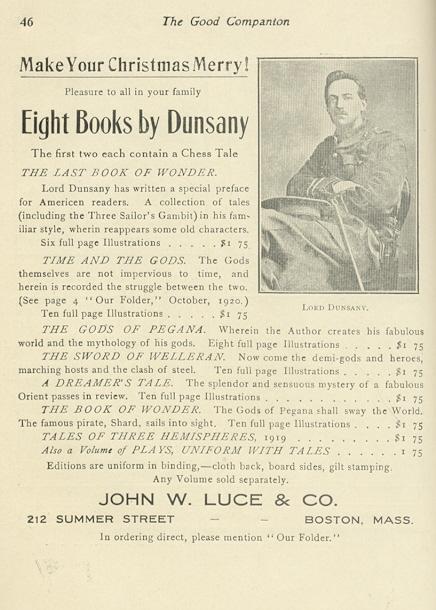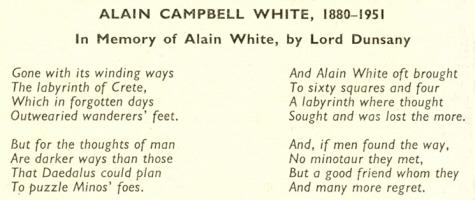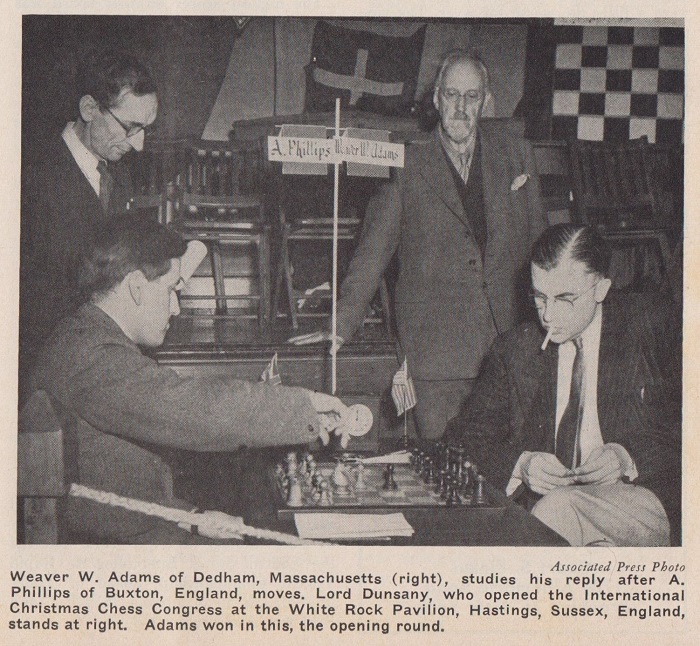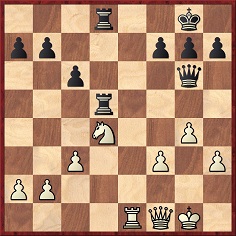
Edward Winter

BCM, April 1943, page 74 (C.N. 661)
‘Man of many parts and distinguished in them all’ was D.J. Morgan’s description of Lord Dunsany in the obituary published on page 311 of the December 1957 BCM, which also remarked:
‘As a man of action he had been soldier, sportsman, traveller and big game hunter. In the literary world he won fame as poet, essayist, story-teller and playwright.’
C.N. 169 gave the following game from the Times Literary Supplement of 25 April 1929, page 343:
José Raúl Capablanca – Lord Dunsany
London, 12 April 1929
Ruy López
1 e4 e5 2 Nf3 Nc6 3 Bb5 a6 4 Ba4 b5 5 Bb3 Nf6 6 Ng5 d5 7 exd5 Ne7

8 d6 Ned5 9 dxc7 Qxc7 10 Nc3 Bb7 11 a4 b4 12 Nxd5 Bxd5 13 Bxd5 Nxd5 14 O-O Be7 15 d4 O-O 16 dxe5 Qxe5 17 Re1 Qd6 18 Ne4 Qc6 19 Bg5 Bxg5 20 Nxg5 Rac8 21 Qf3 Nf6 22 Re2 h6 23 Qxc6 Rxc6 24 Nf3 a5 25 Nd4 Rc5 26 Nb3 Rd5 27 Rae1 Nd7 28 Re4 Nb6 29 Re5 Rfd8 30 Rxd5 Rxd5 31 Kf1 Nxa4 Drawn.

Lord Dunsany wrote an account of the contest on pages 112-113 of his autobiography While the Sirens Slept (London, circa 1945):
‘Early that same spring [1929] Capablanca, perhaps the greatest chessplayer the world has ever known, and at that time Champion of the World [sic], came to London and gave a display at Selfridge’s. He played simultaneous chess against three representatives from each of the seven counties that are nearest to London, which means roughly the seven strongest counties in England, and Mr Selfridge offered a prize to whatever county did best against him. I was asked to be one of the players from Kent. We sat at a row of tables in a long room with a large crowd leaning over us, and Señor Capablanca walked along the row. I was rather anxious that it should not be thought that I had been chosen to play merely because I was president of the Kent Chess Association, and the only way of showing that was to hold out for at least half an hour. I have mentioned earlier my ignorance of the openings, and Capablanca, who of course had first move on every board, chose the opening that probably corresponds with whatever is the most complicated theory in any science, that is to say the Ruy López. I made for my fourth move one that should have come later, not realizing how much it mattered. Of this simple blunder Capablanca naturally took immediate advantage, and I looked very unlikely to hold out for half an hour. But then I began to play, and by sacrificing a pawn got out of the muddle into which I had strayed, though playing with a pawn down against Capablanca did not seem a very hopeful proposition. Curiously enough my blunder saved me, for in the complications of an ordinary Ruy López as played by Capablanca I should no doubt have been easily beaten; but the clock went on and I was still playing, and at last I got the pawn back, and at the end of four hours when play ended, I had an obvious draw, and Capablanca conceded rather reluctantly a draw to my neighbour on my left, so that Kent had scored one point against him, a draw being half; and a player from Hertfordshire had won his game, and, these two counties being equal, the man who had won and we two who had drawn were all given a prize by Selfridges. For Capablanca had beaten all the rest. As the prize was handed to me the representative of the firm who gave it said “And if there is anything you would prefer, do let us know.” The prize was wrapped up in a box, and I said I was sure that there would not be anything that I should prefer to it. But when I got home and opened the box, I found that the prize was a cocktail-shaker; a very handsome one, but still to a chessplayer as useless as reindeer-harness to anyone in a Southern country. So in spite of what I had said, I wrote asking if, with the exception that I have mentioned, I could be given anything else, and I was kindly given, duly inscribed, the largest and most useful thermos flask that I have ever had, and after nearly 15 years it is as good as ever. My game with Capablanca was recorded in The Times, in the Chess Column, that year.’
Lord Dunsany had also played against Capablanca in a simultaneous display at the Imperial Chess Club in London on 22 November 1928. He lost. Source (report only): The Tablet, 15 December 1928.
Extensive chess-related extracts from While the Sirens Slept were published in CHESS, January 1946, pages 82-83 and 85. A few passages were also given in Chess World, 1 December 1946, pages 250-251.
It may also be recalled that when Capablanca died Lord Dunsany published the following epitaph in CHESS, June 1942, page 131:
Now rests a mind as keen,
A vision bright and clear
As any that has been
And who is it lies here?One that, erstwhile, no less
Than Hindenburg could plan,
But played his game of chess
And did no harm to man.

The theme of the harmlessness of chess was taken up again by Lord Dunsany the following year in what is perhaps the finest chess poem ever written. It marked the death of R.H.S. Stevenson and was published on page 74 of the April 1943 BCM:
One art they say is of no use;
The mellow evenings spent at chess,
The thrill, the triumph, and the truce
To every care, are valueless.And yet, if all whose hopes were set
On harming man played chess instead,
We should have cities standing yet
Which now are dust upon the dead.
Other chess poems by Lord Dunsany were ‘Where is it?’ (CHESS, June 1943, page 140) and a composition (first line: ‘Silence. And Silence still’) which he recited when opening the Hastings, 1950-51 congress. That latter poem was published on page 33 of the February 1951 BCM, page 6 of the January-February 1951 American Chess Bulletin and page 127 of The Treasury of Chess Lore by Fred Reinfeld (New York, 1951).
His famous short story ‘The Three Sailors’ Gambit’ can be found on pages 83-85 of CHESS, March 1942, pages 185-192 of Chess Pieces by Norman Knight (London, 1949), pages 204-215 of The Chess Reader by Jerome Salzmann (New York, 1949), pages 65-71 of The Chess Companion by Irving Chernev (New York, 1968), pages 310-317 of Chess in Literature by Marcello Truzzi (New York, 1974) and pages 33-40 of Sinister Gambits by Richard Peyton (New York, 1991). We believe that it first appeared in book form in Lord Dunsany’s The Last Book of Wonder (Boston, 1916). A less familiar short story, ‘The New Master’, was published on pages 138-148 of his book The Little Tales of Smethers and Other Stories (London, 1952). Chernev’s The Chess Companion (pages 49-50) reproduced ‘The Man Who Sidetracked His Brains’ (originally published in 1940).

“Our Folder” (the Good Companions Chess Problem Club), 1 November 1920
In the realm of problem composition Lord Dunsany showed much ingenuity. In the following passage from page 64 of While the Sirens Slept he discusses his approach to creating problems:
‘And while I am on the subject of chess I may say that now and then during the years of which I have been writing I made a chess problem and used to send them to Mr E. Tinsley, for many years the chess editor of The Times Literary Supplement, whose cheery presence was never absent from any important match in or near London. I followed some principles in these problems which will be readily understood even by those who do not play chess. My first principle was that it should look childishly easy, my next, but still more important, was that an examination of it should make it appear entirely impossible, and then if I could add a little humour to the situation I was content. All puzzles may be approached in this manner. A good many of the problems that I sent to Mr Tinsley and that he reproduced in The Times Literary Supplement were “White to play and mate in one move”, fulfilling the first two conditions that I have mentioned, and that it could be done at all under these conditions perhaps fulfilled the third. The following brief sentence is only for chessplayers: one day I invented a new theme in a castling problem, and how very new it was will be appreciated by chessplayers, though perhaps scarcely believed by them, when I say that it was even new to Mr T.R. Dawson. A couple of years later than the year of which I now tell I collected some of these and (hoping that their published solutions would have been forgotten) offered a prize of half a dozen snipe to any members of the Kentish Chess Association who would solve them, for I have always felt that a president should do a little more to justify himself than merely to ornament notepaper; and I tried to amuse the members of the principal Dublin chess club in the same way. What the builder of the labyrinth in Crete was to men’s feet Mr Hubert Phillips is today to their thoughts, and among his intricacies he has printed six of these problems in his Week-end Problems Book, published in 1932. Mine also was the puzzle in that book about how to build a square house with its walls all facing south; as well as something about Big Ben. My problems appeared there in great company, for they follow one of Sam Loyd’s, the American problemist, who might well be called the leader of all whose avocation was to puzzle mankind, in comparison with whose chess problems and other puzzles, to tell what Hitler is going to do next is merely a childish exercise.’
‘Lord Dunsany’s Inferential Problems’ were given on pages 179-184 of the above-mentioned book by Hubert Phillips. One of them (on page 179) was the following:

White to play and mate in four
A later composition by Lord Dunsany, woven into a brief story, was ‘Jorkens’ Problem’, on page 81 of CHESS, January 1949, with corrections by readers (including Lord Dunsany himself) on page 110 of the February 1949 issue. In the early 1940s he invented ‘Dunsany’s chess’, wherein the white army consistently exclusively of pawns, which filled the first four ranks. See page 97 of The Encyclopedia of Chess Variants by David Pritchard (Godalming, 1994).
Lord Dunsany maintained his interest in chess until the end. Page 24 of CHESS, 19 October 1957 acknowledged a contribution by him on an analytical point, and the following issue reported that he had died in Dublin on 25 October, at the age of 79.
(4141)
‘Friendly warning: Read this only when someone is in the house with you.’
Those alluring words by Ellery Queen appeared on page 464 of his anthology 101 Years’ Entertainment The Great Detective Stories 1841-1941 (New York, 1941) by way of introduction to Lord Dunsany’s macabre short story ‘The Two Bottles of Relish’. Chess is mentioned when the narrator, a relish salesman named Smithers, refers to a conversation with the detective, Linley:
‘And so one day I said to Linley, “I wonder with all that knack you have for seeing through a chess problem, and thinking of one thing and another, that you don’t have a go at that Otherthorpe [murder] mystery. It’s a problem as much as chess”, I said.
“There’s not the mystery in ten murders that there is in one game of chess”, he answered.’
The idea is reiterated when Smithers again tries to persuade Linley to investigate the murder:
‘Well, the fact was Linley didn’t take much interest in it at first, but I was so absolutely sure that he could do it that I kept him to the idea. “You can do chess problems”, I said.
“That’s ten times harder”, he said, sticking to his point.
“Then why don’t you do this?”, I said.
“Then go and take a look at the board for me”, said Linley.’
For a general introduction to Lord Dunsany, a useful book, which includes references to chess and his meeting with Capablanca, is Mark Amory’s 1972 biography (referred to in C.N.s 169 and 1889):

(4142)
The position given in C.N. 4141 above is illegal/impossible, and the board therefore needs to be turned 180 degrees, after which the key move for White is 1 Nc6 (or 1 Nd7).
As a curiosity we add that when Lord Dunsany’s famous short story ‘The Three Sailors’ Gambit’ was published in his 1916 volume The Last Book of Wonder, it was entitled (in the heading, although not in the table of contents) ‘The Three Sailors’ Gamble’:

(4146)
From pages 222-223 of Patches of Sunlight by Lord Dunsany (London, 1938), where the author describes sailing in the Red Sea in 1913:
‘I played chess with the captain, as I nearly always do in ships, for I have hardly ever met a captain of a ship who did not play chess well, those 64 squares perhaps providing the readiest land for a holiday, where his thoughts can go ashore for a while when his body is out in an ocean.’

Lord Dunsany
(4286)

Lord Dunsany
Lord Dunsany related his early chess experiences on pages 60-61 of Patches of Sunlight (London, 1938):
‘... In 1895 I went to cram with the Rev. C.S. Isaacson at Hardingham Rectory in Norfolk ... One day I tried to get a game of chess with Mr Isaacson, but it took me some time to do it; because he did not like being bothered by any of his pupils to engage in a contest that experience had shown him was never of any interest to him. Finally he said he would play me one game only, and we played it for the rest of the evening. He beat me, and after that we often played again, and he always beat me, except on Saturdays. On Saturdays I used to beat him, because he was tired after preparing his sermon. I joined the Hingham Chess Club and the Wymondham Chess Club, each of which met once a week; and that year I was asked to play for Norfolk, while I was still only 16. I never did play chess for Norfolk, because I left Hardingham too soon, to go to a crammer’s under a gloomier sky, but I was very pleased at being asked to one day at Yarmouth when I was playing chess for Wymondham against that town. I knew nothing worth knowing about any opening at this time, and often wonder that I got on as well as I did. For instance about a year later I went one day into Simpson’s Divan, close to Charing Cross, where masters and other professionals used to play for a shilling a game. You paid sixpence downstairs, which entitled you to a cigar and to go up to the room in which chess was played. Chess was not mentioned where one bought one’s ticket, and the cigar was evidently thought to be the more important of the two. And who can say, seeing how much ends in metaphorical smoke, that what makes visible smoke is not more important than anything? I bought my cigar-ticket and went upstairs, and there was a Frenchman waiting for a game with a tumbler of water before him into which he was dipping a lump of sugar. I had a game with him and won. But the next time I went there I had the black pieces, which move second, not the white pieces as I had the first time; and the professional with whom I played on this occasion played the Evans Gambit against me, of which, like all other openings, I knew nothing; and it was too much for me. This not only prevented me from getting my head turned, but it rather turned it in the other direction and discouraged me from returning to Simpson’s.’
Below is an inscription by Lord Dunsany in another of his books in our collection, Tales of War (Dublin and London, 1918):

(4295)
A tribute to Alain Campbell White on page 214 of the July 1951 BCM:

(5203)
A poem entitled ‘Lord Dunsany’ by Marcus Cumberlege is given on page 70 of The Poetry of Chess by Andrew Waterman (London, 1981).
From page 55 of CHESS, January 1943:

Some chess books try to fabricate an air of cultivation by inserting quotes, however irrelevant, in chapter headings. From page 114 of Playing Computer Chess by Al Lawrence and Lev Alburt (New York, 1998):

The quote has nothing to do with Sir Arthur Conan Doyle but comes from the short story The Two Bottles of Relish by Lord Dunsany.
From page 467 of the anthology 101 Years’ Entertainment The Great Detective Stories 1841-1941 edited by Ellery Queen (New York, 1941):

(8852)
A poem on page 119 of CHESS, March 1952:

(8853)
‘The New Master’ was reproduced on pages 296-300 of CHESS, 16 April 1955. An editorial comment about chess and machines appeared on page 323 of the 30 April 1955 issue.

Chess Review, February 1951, page 35.
An inscription on the inside front cover of one of our copies of Harry Golombek’s book on the 1954 world championship match between Botvinnik and Smyslov:

The book was signed by Golombek:

One of many photographs from The Graphic shown by Olimpiu G. Urcan (Singapore) in C.N. 10302:

30 March 1929, page 490
From Alan Smith (Stockport, England):
Montague Jones – Lord Dunsany
Living chess, Ramsgate, 30 March 1929
Scotch Game
1 e4 e5 2 Nf3 Nc6 3 d4 exd4 4 Nxd4 Bc5 5 Be3 Nf6 6 Nc3 Bxd4 7 Bxd4 d6 8 Bb5 Bd7 9 O-O O-O 10 f3 Re8 11 Bxc6 Bxc6 12 Ne2 Bb5 13 Bxf6 Qxf6 14 c3 Rad8 15 Nd4 Bxf1 16 Qxf1 c6 17 Rd1 d5 18 exd5 Rxd5 19 h3 Red8 20 Re1 Qg6 21 g4

21...f5 22 Kh2 fxg4 23 fxg4 c5 24 Nf5 Kh8 25 Ne7 Rd2+ 26 Kh1 Qd6 27 Nf5 Qh2 mate.
Source: Brooklyn Daily Eagle, 1 August, 1929, page 27:

A report on the event in the Observer, 31 March 1929, page 12:

(10801)

To the Chess Notes main page.
To the Archives for other feature articles.
Copyright: Edward Winter. All rights reserved.